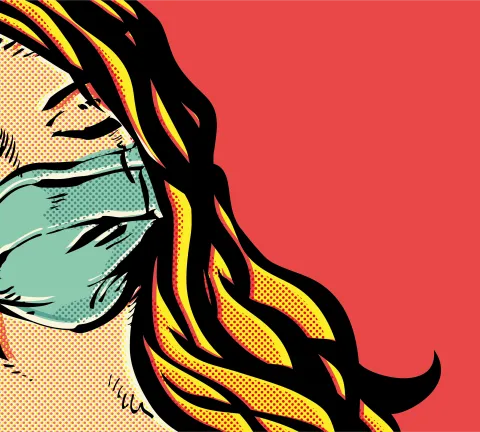by Angelo Maria Barducci, professor of ESLSCA's Luxury Brand Management MBA
Art and Pandemic, it's a perfect blend that has originated the most admired and appreciated masterworks of the whole history of art.
The union of these two entities is effectively an oxymoron: when we think about Art, we have commonly in mind something beauty and harmonious, which is contrasting with the horror and creepiness of a global pandemic event.
But we don't have to forget that the concept of Beauty in Art is deeply rooted with the concept of Mimesis, developed by Plato. This word means "copying" or "imitation" and, for this reason, until roughly the end of the eighteenth century, a work of art was valued on the basis of how faithfully it replicated its subject. A "good and honest" artwork was, for centuries, defined as the representation or replication of something that is beautiful or meaningful. This definition of "good art" has had a profound impact on modern and contemporary artists; as Gordon Graham writes, “It leads people to place a high value on very lifelike portraits such as those by the great masters—Michelangelo, Rubens, Velásquez, and so on—and to raise questions about the value of ‘modern’ art—the cubist distortions of Picasso, the surrealist figures of Jan Miro', the abstracts of Kandinsky or the ‘action’ paintings of Jackson Pollock.”
So, during the many pandemic moments which occur in the unavoidable cycle of "corsi e ricorsi" in history ("courses and appeal", as Giambattista Vico wrote) many painters, sculptors, composers felt the needing to become reporters and to communicate the tragic reality they were living through something less literal than words but more direct to human sensibility: colors, volumes, music notes.
And it doesn't matter the language, the style the artists used to express the terror and abhorrence of a war action or a famine, the final result into the eyes of any observer is the same one, even hundreds year later. "The Triumph of Death", a detached fresco painting dated at the half of the XV century during the Black Death plague and showcased in Palazzo Abatellis Gallery in Palermo, with its great symbolism and realism is as shocking to the human eyes as "Guernica" of Pablo Picasso, the large 1937 oil painting on canvas exhibited in the Museo Reina Sofía in Madrid and painted in response to the bombing of Guernica by Nazi Germany and Fascist Italy at the request of the Spanish Nationalists. Looking carefully to both these artworks, even if they are so distant not only from a chronological point of view but from an aesthetic one eve more, the strength and the violence expressed by the figuration of the gothic fresco is the same one represented by Picasso abstraction five centuries later.
Ars and Thanatos: a fatal relationship which has often weaved together the artists' lives. Guillaume Apollinnaire, Gustav Klimt, Egon Schiele dedicated mostly their entire artistic production to this thematic, and it's quite curious that all these formidable artists dead for the same horrible virus, the Spanish Flu, better known as the 1918 flu pandemic. Lasting from January 1918 to December 1920, this virus infected 500 million people – about a quarter of the world's population at the time and the death toll is estimated to have been anywhere from 17 million to 100 million, making it one of the deadliest pandemics in human history.
Getting more closer to nowadays, the spread of HIV and drug dependence brought many artists to testify the violence and aggressiveness of those modern plagues: Andy Wharhol, Keith Haring, Jean-Michel Basquiat are the undisputed protagonists of Art in the '80s, they became Icons of an enormous and quick success, fast as their own life. Their later work is addressed to political and societal themes (especially homosexuality and AIDS), including sexual allusions that turned into social activism to advocate for safe sex and AIDS awareness. They have been "cursed messengers" of our sick society, which has found its peak into the pandemic we are living in these days.
COVID-19 is irrevocably changing our lifestyle and our habits, it is questioning all the certainties we built up regarding Politics, Finance, Public Health and contemporary artists can't remain unconcerned about it.
Even if maybe too early to speak about a specific Art Movement (Post-Optimism/ Post-Globalization?), the first signs of such revolutionary moment are already showing us in a clear and direct way: a version of Francesco Hayez's famed Kiss wearing a coronavirus mask and holding disinfectant gel by street artist Tvboy or the new illustrations paying homage to the real-life heroes (doctors, nurses, truck drivers) of the Italian comic book writer/artist Milo Manara appared in many Italian cities walls as well as online on the last week of February.
These are all proofs that Art and artists' know-how will be still able to represent our every-day life, to face and solve the problems of our contemporaneity, to fight the "social distancing" as well as the psychosis-inducing virus, showing us their vision of our future. So, in these days of confinement, my advice is to keep us updated on the new artists and artistic movements will come out in the worldwide cultural panorama because we will learn from them how a pandemic can be seen and transformed somehow into something poetic and aesthetic because, as Mahatma Gandhi used to say “Life isn't about waiting for the storm to pass...It's about learning to dance in the rain.”
